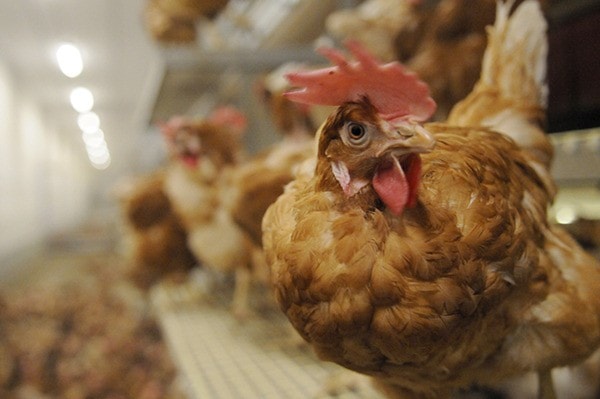Most evenings, you can find Scott Janzen in his Abbotsford barn, making sure his thousands of chickens get to sleep properly.
His birds will come up to him, peck at his legs, hop onto his shoulder, leap into the air and fly past his head.
Janzen has run his own farm for eight years, and for most of that time, his chickens – like the vast majority both in B.C. and around North America – were confined to cages. Last year, though, Janzen decided to join an increasing number of egg producers and make the considerable investment to convert one of his two barns to housing free-run chickens.
It’s a move that came at a substantial cost, with the hope of profits down the line.
“I realized that’s the way of the future so I needed to personally change to meet the needs of our customers,” Janzen said.
And with the announcement earlier this month from fast food giant McDonald’s that it would source all its eggs from cage-free farms within a decade, Janzen’s decision is looking even better.
Indeed, producers in Abbotsford – which is home to 67 egg farms, representing more than half of the B.C.’s total – are well-positioned to take advantage of an industry-wide move towards eggs generated by birds living outside of cages. Those include free-run birds, which live in open barns, and free-range birds, which have access to the outside. A smaller subset of the latter category lays eggs that are certified as “organic.”
In 2014, a little more than 16 per cent of the eggs produced in British Columbia came from non-caged animals, up from nine per cent in 2007. Those numbers might be ticking up slowly, but with 840 million eggs produced in B.C. last year, they represent a huge quantity of food. Those “specialty eggs” are also sold for more money, and now represent around 22 per cent of all revenue. Driven largely by demand from grocery stores and their customers, B.C. already produces the highest proportion of specialty eggs in Canada.
Now, with McDonald’s and other restaurants seeking to differentiate themselves by emphasizing free-run eggs, the shift towards non-caged egg-layers will take “a quantum leap,” according to Brad Bond, the chair of the Abbotsford-based BC Egg Marketing Board.
The shift will only increase the incentive to produce more cage-free eggs, a move that will bring its own challenges and benefits.

Caged birds are cheaper in a variety of ways, from the amount of feed they eat, to the space they occupy, to the chicks they start out as.
And that’s just the beginning of it.
“It’s a 100 per cent new way of thinking,” Janzen told The News. “Your main challenge is the management of them when they’re loose and running around.”
Janzen still has a caged bird operation, but his smaller, 6,000-bird free-run barn consumes more of his time. When he speaks about his free-run chickens, Janzen sounds less like a farmer and more like a teacher or parent.
He talks about putting his birds “to bed” and ensuring they’re “staying where they need to stay.”
Chickens must be taught to head to their roosts before they lay eggs. If they get too comfortable on the barn floor, they’ll lay eggs there, where they will either be trampled underfoot or eaten by the chickens themselves. Conflicts must also be managed and prevented, so, like any authority figure, sometimes Janzen needs to just make his presence felt.
“The more time you spend in your barn, they don’t get riled up,” he said.
It’s a shift from how he used to produce eggs, but Janzen says that problem-solving and bird management is enjoyable.
And with McDonald’s recent move and the publicity surrounding it, he is predicting more farmers will make the move to free-run eggs.
“I would say this would be just the tip of where it’s going to go,” he said.

Although animal welfare activists applauding McDonald’s move towards eggs from cage-free chicken say the end goal should be meat certified as “organic” by a third party, Janzen says the transition to such a system will largely depend on retail and individual consumers.
Decades ago, Janzen noted, all eggs were produced on what would come to be known as “free-range” farms. But pressure for more, and cheaper, eggs led to larger, more institutional farms.
Now, as demand trends in the other direction, farmers are heading back to their roots, although the change is slowed due to the capital costs.
In the meantime, Dwight Yochim, the executive director of the BC Egg Marketing Board, said some of the calls for reforms overlooks some of the birds’ own preferences. Calls for birds to be fed organically produced grass, for example, overlook the fact that chickens, like humans, are omnivores that eat both meat and plants. And the free-range birds actually die more often, as they are more susceptible to diseases like salmonella that come from eating eggs laid on the ground and trampled underfoot.
Nevertheless, as Janzen said, “What the consumer wants, the farmers will produce.”
Outside his free-run barn, he has fenced off a small portion of land to teach his curious, but wary, birds about the great outside. The education is necessary because, thanks to a request for free-range eggs from a major grocery chain, the birds will have two acres of land to roam after they finish laying eggs in the morning.
He chuckles at the large plot of land his birds will soon have licence to roam, but is happy with the direction his farm is going.
“There are a lot of farmers out there who want to change,” he says. “When a bird pecks your toes and sits on your shoulder and flies around you, it has a different feel to it, and I think it’s a lot of fun. It’s not really a job, it’s really entertaining to me.”

